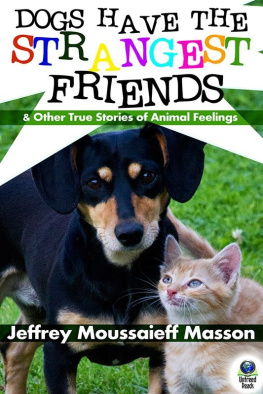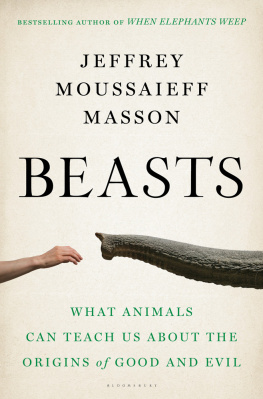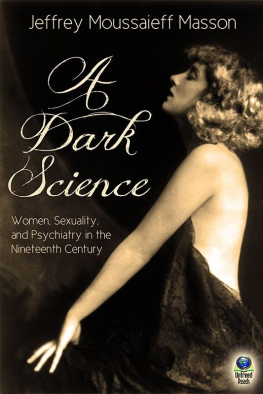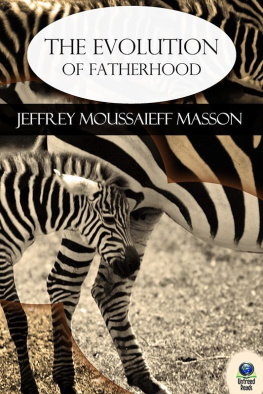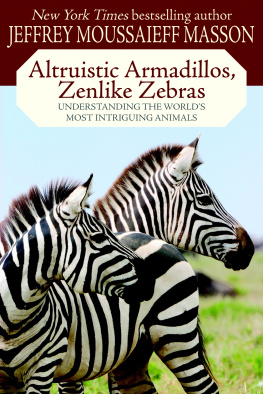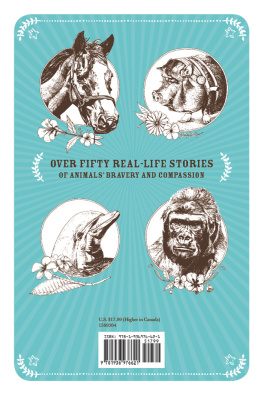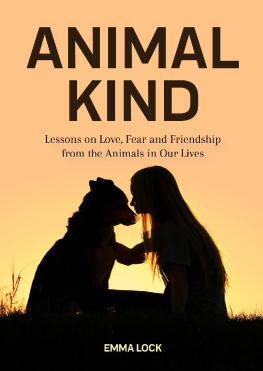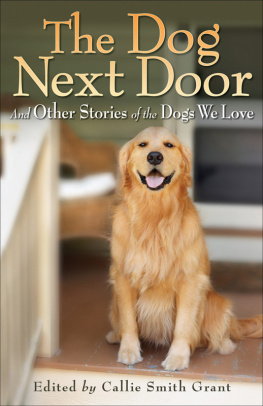
Table of Contents
Dogs Have the Strangest Friends
By Jeffrey Moussaieff Masson
Copyright 2013 by Jeffrey Moussaieff Masson
Cover Copyright 2013 by Ginny Glass and Untreed Reads Publishing
The author is hereby established as the sole holder of the copyright. Either the publisher (Untreed Reads) or author may enforce copyrights to the fullest extent.
Illustration Copyright 2000 by Shirley Felts.
Previously published in print, 2000.
This ebook is licensed for your personal enjoyment only. This ebook may not be resold, reproduced or transmitted by any means in any form or given away to other people without specific permission from the author and/or publisher. If you would like to share this book with another person, please purchase an additional copy for each person you share it with. If youre reading this book and did not purchase it, or it was not purchased for your use only, then please return to your ebook retailer and purchase your own copy. Thank you for respecting the hard work of this author.
While the author has made every effort to provide accurate telephone numbers and Internet addresses at the time of publication, neither the publisher nor the author assumes any responsibility for errors, or for changes that occur after publication. Further, the Publisher does not have any control over and does not assume any responsibility for author or third-party websites or their content.
Also by Jeffrey Moussaieff Masson and Untreed Reads Publishing
Against Therapy
Final Analysis
My Fathers Guru
Raising the Peaceable Kingdom
The Assault on Truth
The Cat Who Came in From the Cold
The Evolution of Fatherhood
http://www.untreedreads.com
Dogs Have the Strangest Friends
& Other True Stories of Animal Feelings
Jeffrey Moussaieff Masson
Illustrated by Shirley Felts
For Ilan
J.M.M.
To Mick, Martin, and Katy S.F.
ACKNOWLEDGEMENTS
I want to thank Dave Sidon, the director of Wildlife Images in Oregon, and Sheila Siddle, the director of the Chimfunshi Wildlife Orphanage Trust in Zambia, for pro viding me with material that I used in this book. I also want to thank the wonderful people at Dutton Childrens Books: first of all, Donna Brooks, who has a magic hand when it comes to editing, her assistant, Alissa Heyman, copy editors Andrea Mosbacher and Tiffany Yates, proofreaders Shelly Perron and Nora Reichard, and designer Ellen M Lucaire. I especially want to thank Shirley Felts for her sublime paintings, which I look at over and over, each time with new delight. Finally, I want to thank the children who will read these stories and say, I always knew that animals had feelings.
INTRODUCTION
Most of you have probably never had much difficulty recognizing that animals have feelingsstrong feelings, much like those you and I have. We feel sad. We feel lonely. We feel happy, even joyful. I believe, and perhaps you may, too, that animals also feel those emotions. Many of you have become close friends with your companion animals (I try to avoid the word pet ): dogs, cats, birds, or other animals, such as rabbits, horses, hamsters, or gerbils. (Ill bet there is even somebody out there who has become friends with a fish.) Some of you who live on farms may have gotten to know a cow, a goat, or a sheep and have seen them show affection or fear or sadness. Those of you who have lived with animals in your house know that when you call your dog, she comes. Or if you call your cat, he will at least look up to let you know he has heard, even if he decides not to come over to you.
Animals we live with usually know their names, and they know that their names refer to them and only them. They have a sense of identity. When somebody calls out to you on the street, you know that you are being called. You have a distinct sense of yourself as a person different from all other people. I believe animals feel this sense of distinctness as well. Moreover, your dog will come to you but usually not to a stranger who calls his name. He knows that he is being referred to, but he does not feel close to the stranger, does not trust him yet, and refuses to acknowledge any special bond with him that would cause him to come when called. So the dog is making a kind of judgment as to just who is calling. Into that judgment come feelings: the dog feels close or wary, affectionate or indifferent. When you call your dog, he runs over, his tail wagging, glad to have been called, and eager to see what you want. When a dog hears your voice among others, he feels happy and shows you his happiness. His wagging his tail is as clear as if he were saying: Im glad you called. It is his language, and you understand it perfectly well. Moreover, he knows that you know what it means. It is one of the great mysteries and pleasures of life that we understand the physical signs of emotions that dogs use as easily as they seem to understand the signs of our emotions.
Even if some of you have never had a companion animal, I am sure you have thought a lot about animals, and it has never occurred to you that a whale or a dolphin or a lion or an ape or an elephant cant feel the feelings you imagine them feeling. After all, animals have brains just as we do, and there are parts of their brains that specialize in feelings. In fact, we should always remember that we are animals, too. There are many things we share with our animal relatives. We all have developed intelligence that allows us to survive in the environment we are born into. We all have feelings for our families,parents love their children, and children love their parents partly because this helps us to thrive in our world. I believe that just as we have feelings, so do animals. They can feel love and compassion and loneliness and boredom and friendship just as we do. I believe animals have nearly all the feelings we do, and maybe even some that we dont.
Some people are willing to acknowledge that animals look as if they feel happiness by the way they move their bodies. But they argue that we can never be certain that the happiness they feel is the same happiness that we humans feel. It is true that when a dog raises her nose and sniffs the air and seems to smile with delight, we may not know exactly what she is feeling. Perhaps the pleasure she takes in the natural world is a little bit different from the pleasure we take in that same world. Nevertheless, we recognize what the dog is feeling. So, too, when we see a dog chained up in a yard all by herself, looking lonely and sad, we cannot say that the dog feels exactly what we would feel if confined somewhere. But we know for certain that the dog is feeling something like what we feel when we are lonely. We can feel empathy for the dog, just as a dog who has lived with you for years knows when you feel sad and comes over to lick your face or your hand in sympathy. This kind of empathy and sympathy, these feelings that cross over the species barrier and can be felt between two different animals, is one of the great wonders of our world.
Why am I so eager to urge people to see that animals have feelings? It is because for so many years people have been hurting animals, eating them, hunting them, taking their skin or fur for clothing or furniture, performing painful experiments on them, at least in part because they have lost the intuitive appreciation that animals experience suffering and other emotions not so differently from the way we do.
Many indigenous peoples have, for thousands of years, been taking animals lives for food and shelter and clothing, despite a deep belief in those animals abilities to feel and to suffer. In fact, because indigenous peoples held a deep belief in an animals soul, in its being, they created and performed rituals to convey their respect for the animal and acknowledge gratitude, even sorrow, for the life they were taking. Today many, perhaps most, people do believe that animals can feel things. But this belief is no longer a part of our shared culture and our rituals. Perhaps because of that, weve lost the respect necessary to behave in accord with our belief. Modern urbanized life has removed us more and more from the reality of animal suffering that lies behind much of the food, drugs, and other goods that we enjoy. If our culture could reestablish its understanding that when a cat cries out or a dog shrinks away, it is because it suffers just as we do, then maybe people would be less likely to do the things to animals that cause them suffering.
Next page
